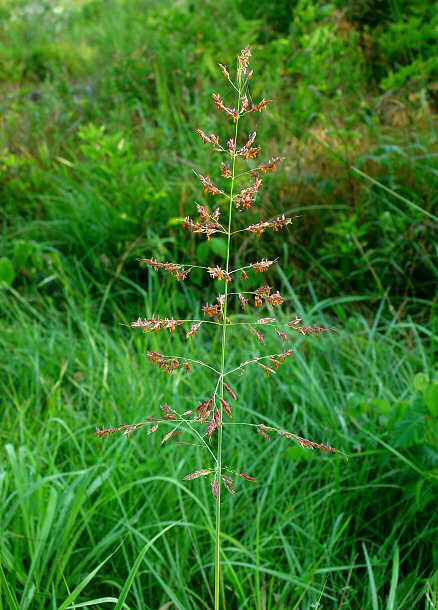

Johnsongrass is a perennial grass that can grow up to seven feet tall. It spreads easily by rhizomes. Leaf blades are typically about 1 inch wide and up to 2 feet long. In the fall, large open seed heads that are yellow to purplish develop.

Johnsongrass is highly invasive and can outcompete native grasses. It is frequently seen along roadsides. Thick stands of Johnsongrass decreases the diversity of native plants and decreases forage for many animals dependent on those native plants. Healthy plants can provide good forage for livestock. However, foliage of Johnsongrass can produce toxic amounts of cyanide if growing under stressful conditions, such as cold (i.e., frost), extreme heat, or drought and may be poisonous to livestock when ingested. High nitrate levels in the plant can complicate the problem and produce nitrate poisoning in sheep and cattle. All of these factors make Sorghum halepense one of the 10 most noxious weeds in the world.

There are multiple control strategies for Johnsongrass but early action is always encouraged.
Johnsongrass is present in all US states except AK and MN. It generally grows in fertile bottomlands along creek and river banks and in upland fields. Irrigation ditch banks are also overgrown with johnsongrass, and seed is carried by the water. In a new location, johnsongrass spreads rapidly and soon becomes a serious problem. Tillage equipment can spread the rhizomes, and birds spread the seed.
This plant was initially introduced to the US from Turkey as a forage crop in the 1800s. While this is generally considered an agricultural pest, it also makes its way into natural systems. It is native to the Mediteranean region of Europe and Asia.
http://www.fs.fed.us/database/feis/plants/graminoid/sorhal/all.html#INTRODUCTORY
http://www.oardc.ohio-state.edu/weedguide/singlerecord.asp?id=80
http://extension.missouri.edu/p/IPM1007-69
https://plants.usda.gov/core/profile?symbol=SOHA
https://extension2.missouri.edu/g4872
http://www.tsusinvasives.org/home/database/sorghum-halepense